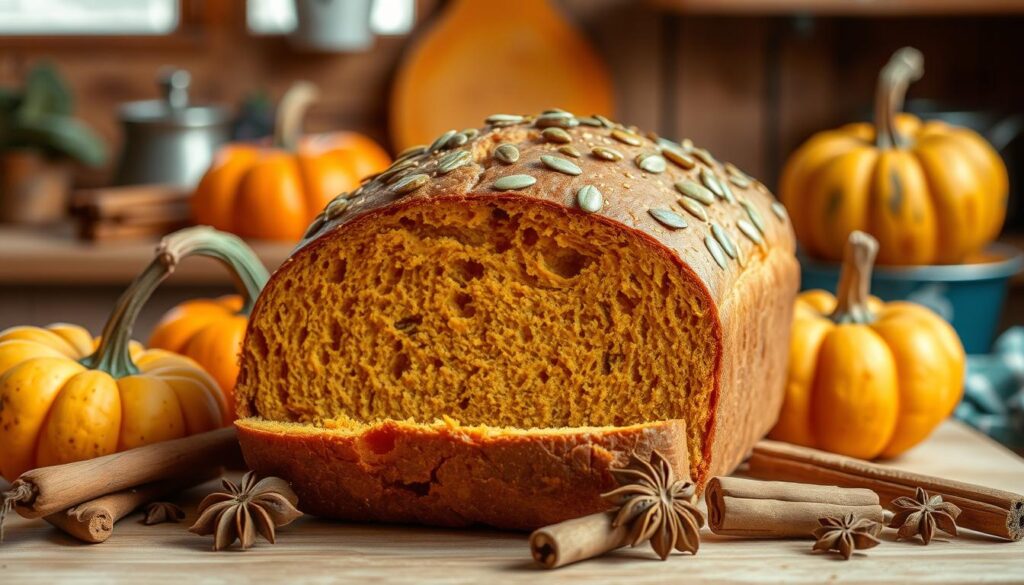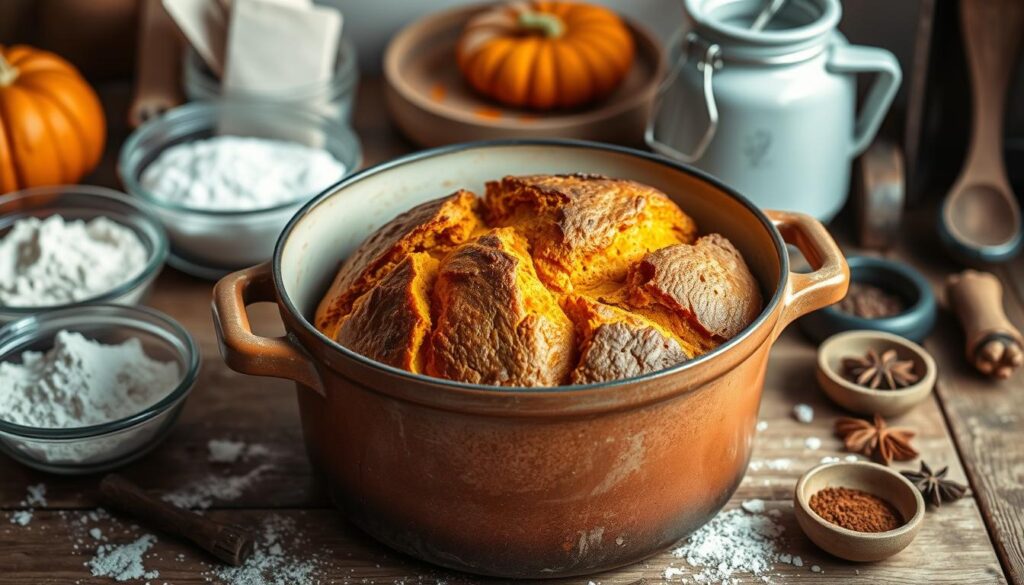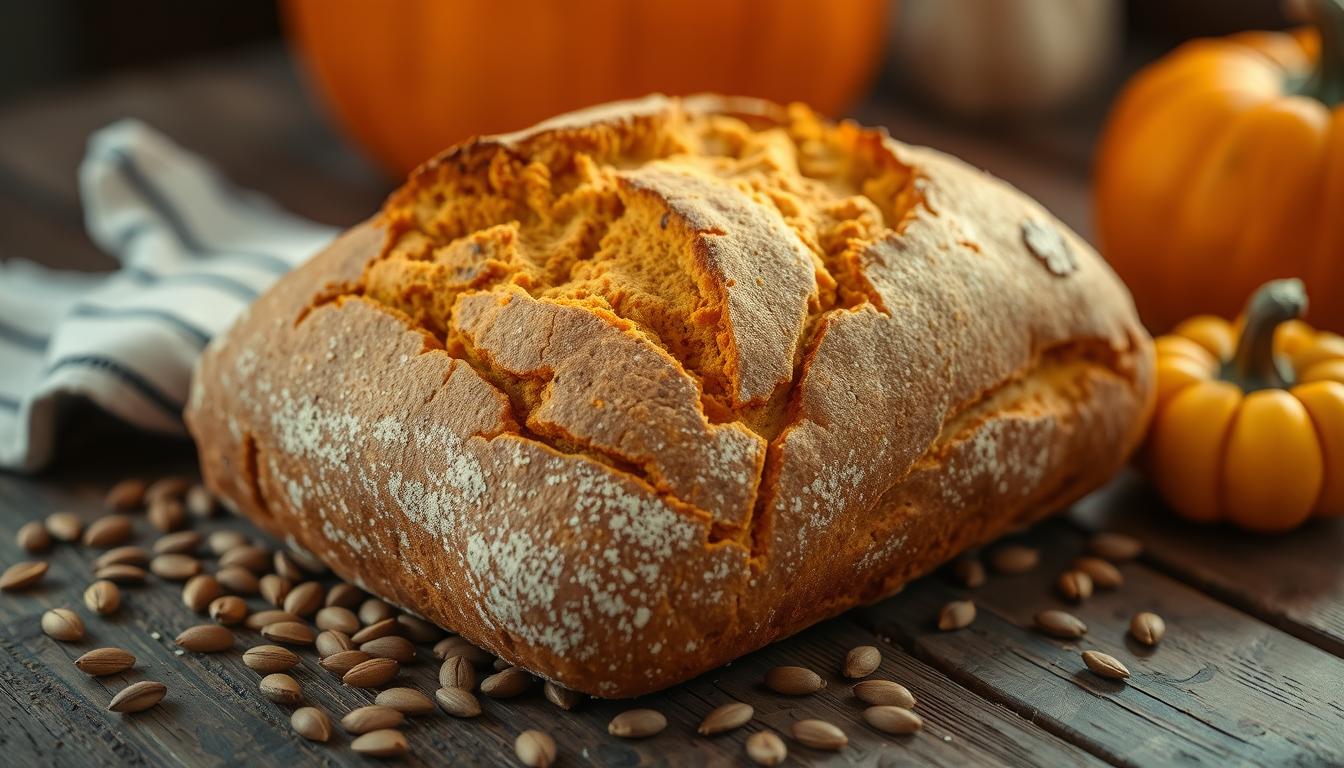Embrace the flavors of fall with this delectable pumpkin sourdough bread recipe. This artisan loaf combines sourdough’s tangy notes with pumpkin’s rich, creamy essence. It’s a truly exceptional baking experience for home cooks.
Whether you’re a seasoned sourdough enthusiast or new to artisan baking, this recipe will guide you. It will help you create a mouthwatering pumpkin sourdough bread that’s sure to impress.
Key Takeaways
- Discover the magic of pumpkin sourdough bread, a flavorful autumn treat.
- Learn the science behind sourdough fermentation and the benefits of adding pumpkin.
- Gather the essential ingredients and equipment to bake the perfect pumpkin sourdough loaf.
- Master the art of shaping, fermenting, and baking for a picture-perfect crust and crumb.
- Explore storage and serving tips to enjoy your homemade pumpkin sourdough bread to the fullest.
Understanding the Magic of Pumpkin Sourdough Bread
Sourdough bread is a fascinating creation. It combines art and science in a unique way. Adding pumpkin to this process makes the bread even more special.
The Science Behind Sourdough Fermentation
The magic of sourdough comes from its fermentation. A sourdough starter, full of wild yeasts and bacteria, is at its heart. This starter makes the bread tangy and chewy.
Benefits of Adding Pumpkin to Your Bread
Pumpkin adds more than color to your bread. It’s packed with vitamins, minerals, and antioxidants. Adding pumpkin makes your bread healthier and tastier.
What Makes This Recipe Special
This pumpkin sourdough is a treat for your senses. The pumpkin’s sweetness pairs well with the tangy dough. The bread is soft and chewy, with a crunchy crust.
Enjoy it toasted or as a sandwich base. This bread will quickly become a favorite in your kitchen.

Essential Ingredients and Equipment for Perfect Results
Making a delicious pumpkin sourdough bread at home needs the right ingredients and tools. Let’s explore what you need to get that bakery-quality bread in your kitchen.
The base of your pumpkin sourdough bread is flour. Mix whole grain bread flour with all-purpose flour for the best texture and rise. Adding pumpkin puree gives the bread a lovely orange color, adds moisture, and a hint of sweetness.
For those autumn flavors, include warm spices like cinnamon, nutmeg, and a bit of ground cloves. A bit of butter or olive oil adds richness to the dough.
For the perfect crust, a Dutch oven or heavy-duty baking vessel is key. A sturdy dough scraper helps shape the dough. And a lame or razor blade is needed for scoring the loaf before baking.
| Ingredient | Amount |
|---|---|
| Whole Grain Bread Flour | 3 cups |
| All-Purpose Flour | 1 cup |
| Pumpkin Puree | 1 cup |
| Sourdough Starter | 1/2 cup |
| Water | 1 cup |
| Unsalted Butter | 2 tablespoons |
| Cinnamon | 1 teaspoon |
| Nutmeg | 1/2 teaspoon |
| Cloves | 1/4 teaspoon |
| Salt | 1 teaspoon |
With these ingredients and tools, you’re ready to make the perfect pumpkin sourdough bread in your kitchen.

Preparing Your Sourdough Starter for Pumpkin Bread
Making the perfect pumpkin sourdough bread begins with a healthy sourdough starter. Before baking, it’s key to prepare and feed your starter right. This ensures it’s ready for your pumpkin bread.
Feeding Schedule for Active Starter
To keep your starter strong, follow a regular feeding schedule. Feed it at least once a day. If you’re using it soon, feed it twice a day. This keeps it active and ready for your pumpkin bread.
Signs of a Healthy Starter
A healthy starter shows several signs:
- A bubbly, active look with air pockets
- A nice, slightly sour smell
- It doubles in size in 8-12 hours after feeding
Troubleshooting Common Starter Issues
If your starter isn’t acting right, don’t worry. You can fix it. Issues like a slow starter can be solved by changing the feeding schedule, temperature, or flour to water ratio. Be patient and consistent, and your starter will be ready for your pumpkin bread.
Remember, caring for your sourdough starter is crucial for great pumpkin sourdough bread. With a bit of effort, you’ll make a delicious and flavorful loaf.
Step-by-Step Guide to Making Pumpkin Sourdough Bread
Get into the fall spirit with this tasty pumpkin sourdough bread recipe. Whether you love artisan baking or just want to spice up your baking, this guide will help you make a delicious loaf. It’s perfect for fall baking lovers.
First, get your ingredients ready. You’ll need sourdough starter, pumpkin puree, flour, salt, and warm spices like cinnamon, ginger, and nutmeg. Make sure to measure each ingredient carefully for the best results.
- In a big mixing bowl, mix the sourdough starter, pumpkin puree, and some flour. Keep mixing until it’s a shaggy dough.
- Knead the dough until it’s smooth and elastic. This might take 10-15 minutes, either by hand or with a stand mixer.
- Let the dough rest for 30 minutes to an hour. This helps the gluten develop more.
- Add the rest of the flour, salt, and spices to the dough. Knead until it’s smooth and easy to shape.
- Put the dough in a greased bowl, cover it, and let it ferment for 6-12 hours. This depends on your kitchen’s temperature.
- When the dough has doubled, shape it into a round loaf. Place it in a parchment-lined basket or Dutch oven.
- Cover the dough and let it proof for 2-4 hours. It should puff up and be ready to bake.
To avoid common what not to do with sourdough? mistakes, watch the dough closely. Adjust the proofing times and temperatures as needed. With practice, you’ll make amazing artisan baking pumpkin sourdough bread!
| Ingredient | Quantity |
|---|---|
| Active sourdough starter | 1 cup |
| Pumpkin puree | 1 cup |
| All-purpose flour | 3-4 cups |
| Salt | 1 tsp |
| Ground cinnamon | 1 tsp |
| Ground ginger | 1/2 tsp |
| Ground nutmeg | 1/4 tsp |
“Baking is like washing dishes, you should do it with love and dedication.”
Mastering the Art of Dough Fermentation
Making delicious fermented bread, like sourdough, needs a good grasp of dough fermentation. This step boosts the flavor and texture of your loaf. It also brings out the nutritional benefits of fermented bread. Let’s explore how to master dough fermentation for your pumpkin sourdough bread.
Bulk Fermentation Tips
The bulk fermentation stage is where the magic happens. Here, the dough changes, getting complex flavors and a great structure. To succeed in bulk fermentation, follow these tips:
- Keep the temperature between 75-85°F (24-29°C) for yeast and bacteria to thrive.
- Avoid overworking the dough to keep the final texture and crumb perfect.
- Fold the dough gently at regular times to add air and promote even growth.
Understanding Proofing Times
The proofing stage is the last step before baking. It’s where the dough rises one last time. To get the right texture and structure for your pumpkin sourdough, consider these guidelines:
- Watch the dough’s volume increase, aiming for a 50-100% rise in the final proof.
- Adjust proofing times based on your kitchen’s temperature. Cooler places need longer proofing.
- Do the “poke test” to check if the dough is ready. Gently press your finger into the dough and see how it bounces back.
Temperature Control Essentials
Temperature is key in fermentation and proofing stages of your pumpkin sourdough bread. The right temperature is essential for a perfect crumb and crust. Remember these temperature control tips:
| Stage | Optimal Temperature Range |
|---|---|
| Bulk Fermentation | 75-85°F (24-29°C) |
| Final Proof | 70-85°F (21-29°C) |
| Baking | 425-450°F (218-232°C) |
By mastering dough fermentation, you’ll get the most out of your pumpkin sourdough bread. You’ll achieve a perfect balance of flavor, texture, and nutrition.
Baking Techniques for the Perfect Crust and Crumb
Making the perfect crust and crumb in homemade pumpkin sourdough bread is an art. With a few key baking techniques, you can improve your Dutch oven skills. This will make a whole grain bread that everyone will love.
A Dutch oven is key for a crisp, golden crust. It traps steam, helping the dough rise and bake well. When you remove the lid, the heat caramelizes the sugars, making a beautiful crust.
Getting the right crumb texture is all about proofing and baking times. Too long and it’s dense, too short and it’s doughy. This recipe helps you find the perfect balance. You’ll get a light, airy crumb full of pumpkin and sourdough flavors.
| Baking Technique | Benefit |
|---|---|
| Using a Dutch Oven | Traps steam, creating the ideal environment for a crisp crust |
| Monitoring Proofing Times | Ensures the dough has the perfect rise and texture |
| Adjusting Baking Temperatures | Allows for a well-developed crust and a light, airy crumb |
With these techniques, you can make pumpkin sourdough bread that looks and tastes amazing. So, put on your apron, preheat your Dutch oven, and impress everyone with your homemade loaves.
Storage and Serving Suggestions
Keeping your homemade pumpkin sourdough bread fresh and flavorful is important. To do this, using the right storage methods is key. Also, serving your bread in creative ways can make your meals more special and show off its unique taste.
Proper Storage Methods
For the best taste, store your pumpkin sourdough bread at room temperature. Use a paper or linen bag, not plastic, to keep it fresh. If you need to keep it longer, slice it and freeze it in a sealed container. Just thaw it at room temperature when you’re ready to eat it.
Creative Serving Ideas
Pumpkin sourdough bread is great for many dishes. Try it with pumpkin butter for a sweet treat. Or, use it for savory sandwiches with roasted veggies and herbed cream cheese. For a dessert, serve it with honey or cinnamon sugar.
Reheating Tips
If your bread’s crust isn’t as crisp as you like, you can fix it. Just warm the slices in a 350°F (175°C) oven for 5-7 minutes. This will make the bread warm and crispy again.
By following these tips, you can enjoy your homemade pumpkin sourdough bread even more. Remember, is sourdough a healthier bread option? and is it ok to eat sourdough bread everyday? as you use this versatile bread in your cooking.
Troubleshooting Common Issues
Making the perfect pumpkin sourdough bread can be a rewarding yet challenging process. But don’t worry, we’ve got you covered. If you face issues like a dense crumb, under-proofing, or lack of oven spring, we have solutions for you.
One common mistake is over-kneading the dough, which can make it tough and dense. To avoid this, handle the dough gently and don’t over-knead it. Also, watch your fermentation times closely. Under-proofing can make the loaf flat and dense, while over-proofing can cause it to collapse in the oven.
If you’re having trouble with your sourdough starter, neglecting its feeding schedule is a big mistake. Make sure to feed your starter regularly and check its activity level. A healthy, active starter is key to getting the perfect rise and crumb in your pumpkin sourdough bread. By troubleshooting these common issues and adjusting your process, you’ll soon be baking delicious pumpkin sourdough bread at home.
FAQ
What does pumpkin sourdough bread taste like?
Pumpkin sourdough bread is a mix of sweet pumpkin and tangy sourdough. The pumpkin adds a soft texture and a hint of sweetness. Meanwhile, the sourdough gives it a unique tang and a bit of sourness.
Is sourdough a healthier bread option?
Yes, sourdough is better for you than regular bread. It’s easier to digest because the fermentation breaks down gluten. It also has more nutrients like B vitamins and probiotics. Plus, it doesn’t raise blood sugar levels as much.
What are some common mistakes to avoid when working with sourdough?
Avoid these mistakes with sourdough:
– Don’t neglect your sourdough starter.
– Watch out for overproofing or underproofing.
– Make sure to bake at the right temperature and time.
– Handle the dough gently to keep it airy.
– Score the dough before baking for even rising.
What is the difference between sourdough bread and regular bread?
Sourdough uses wild yeast and bacteria, while regular bread uses commercial yeast. This makes sourdough taste more complex and have a chewier texture. It also lasts longer than regular bread.
Is it okay to eat sourdough bread every day?
Eating sourdough daily is safe and healthy. It’s easier to digest and has more nutrients. Just remember to eat it in moderation as part of a balanced diet.
What is the biggest mistake you can make with your sourdough starter?
The biggest mistake is neglecting your sourdough starter. If you don’t feed it regularly or store it wrong, it can die or get contaminated. Keep it alive by feeding it often and giving it a good home.


2 thoughts on “Delicious Pumpkin Sourdough Bread Recipe Made at Home”